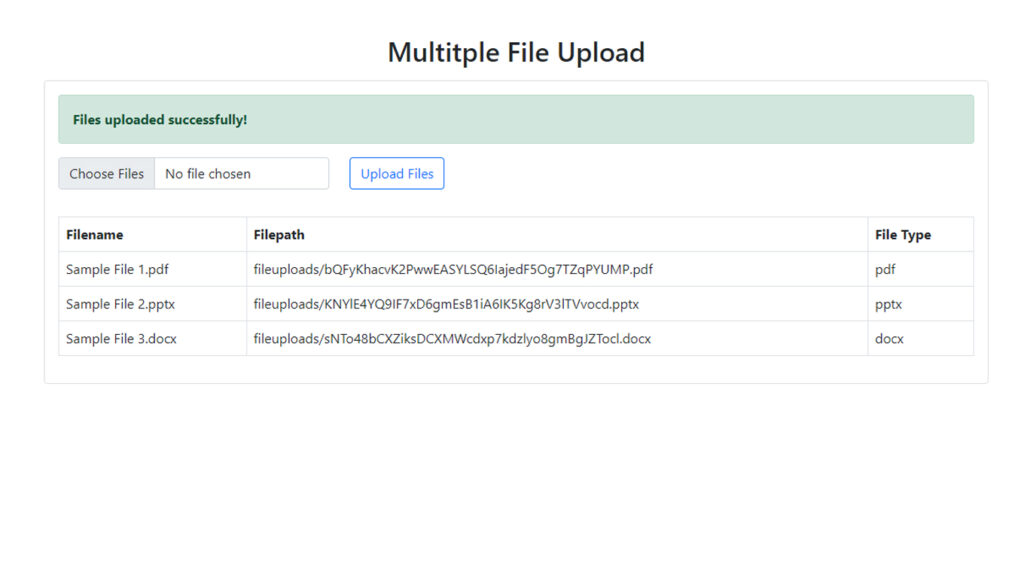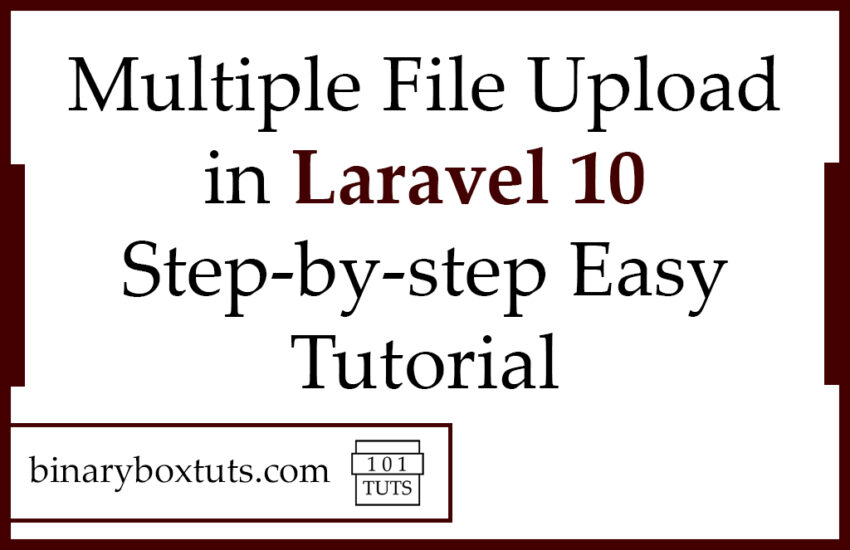Contents
Today I will teach you to make a multiple file upload in Laravel 10. Uploading files is common on most online platforms today, like uploading photos on social media, uploading videos on a video-sharing platform, or uploading a resume on a job searching site.
We will be using Laravel 10 in this tutorial. Laravel is a free, open-source PHP Web Framework intended for the development of web applications following the MVC (Model-View-Controller) architectural pattern. Laravel is designed to make developing web apps faster and easier by using built-in features.
Prerequisite:
- Composer
- MySQL
- PHP >= 8.1
Step 1: Install Laravel 10
First, select a folder where you want Laravel to be installed then execute this command on Terminal or CMD to install Laravel 10:
Install via composer:
composer create-project laravel/laravel:^10.0 laravel-10-multiple-file-upload
Install via Laravel Install:
laravel new laravel-10-multiple-file-upload
Step 2: Set Database Configuration
Open the .env file and set the database configuration:
.env
DB_CONNECTION=mysql
DB_HOST=127.0.0.1
DB_PORT=3306
DB_DATABASE=your database name(laravel_9_multiple_file_upload)
DB_USERNAME=your database username(root)
DB_PASSWORD=your database password(root)
Step 3: Create Model and Database Migration
Model – it is a class that represents a database table.
Migration – like version control for the database that allows us to modify and share database schema to your team.
Execute this command on the Terminal or CMD to create a model and migration:
php artisan make:model FileUpload --migration
After this command, you will find one file in this path “database/migrations” and put the code below on the migration file.
<?php
use Illuminate\Database\Migrations\Migration;
use Illuminate\Database\Schema\Blueprint;
use Illuminate\Support\Facades\Schema;
return new class extends Migration
{
/**
* Run the migrations.
*/
public function up(): void
{
Schema::create('file_uploads', function (Blueprint $table) {
$table->id();
$table->string('filename');
$table->string('filepath');
$table->string('type');
$table->timestamps();
});
}
/**
* Reverse the migrations.
*/
public function down(): void
{
Schema::dropIfExists('file_uploads');
}
};
Run the migration by executing the migrate Artisan command:
php artisan migrate
Step 4: Create A Controller
Execute this command to create a controller:
php artisan make:controller FileUploadController
This command will generate a controller at “app/Http/Controllers/FileUploadController.php”. Open the file and insert these codes:
<?php
namespace App\Http\Controllers;
use Illuminate\Http\Request;
use App\Models\FileUpload;
class FileUploadController extends Controller
{
public function index()
{
$fileUplaods = FileUpload::get();
return view('file-upload', ['fileUploads' => $fileUplaods]);
}
public function multipleUpload(Request $request)
{
request()->validate([
'fileuploads' => 'required',
'fileuploads.*' => 'mimes:doc,pdf,docx,pptx,zip'
]);
$files = $request->file('fileuploads');
foreach($files as $file){
$fileUpload = new FileUpload;
$fileUpload->filename = $file->getClientOriginalName();
$fileUpload->filepath = $file->store('fileuploads');
$fileUpload->type= $file->getClientOriginalExtension();
$fileUpload->save();
}
return redirect()->route('fileupload.index')->with('success','Files uploaded successfully!');
}
}
Step 5: Register Routes
After creating a controller, register these 2 routes.
routes/web.php
<?php
use Illuminate\Support\Facades\Route;
use App\Http\Controllers\FileUploadController;
/*
|--------------------------------------------------------------------------
| Web Routes
|--------------------------------------------------------------------------
|
| Here is where you can register web routes for your application. These
| routes are loaded by the RouteServiceProvider within a group which
| contains the "web" middleware group. Now create something great!
|
*/
Route::get('/', function () {
return view('welcome');
});
Route::get('/file-upload', [FileUploadController::class, 'index'])->name('fileupload.index');
Route::post('/multiple-file-upload', [FileUploadController::class, 'multipleUpload'])->name('multiple.fileupload');
Step 6: Create Blade File
Blade is the simple but powerful templating engine in laravel. blade view files have a .blade.php files extension and are usually stored in “resources/views/” folder.
Create this blade file and insert these codes:
resources/views/file-upload.blade.php
<!DOCTYPE html>
<html>
<head>
<title>Multitple File Upload</title>
<link href="https://cdn.jsdelivr.net/npm/bootstrap@5.0.2/dist/css/bootstrap.min.css" rel="stylesheet" integrity="sha384-EVSTQN3/azprG1Anm3QDgpJLIm9Nao0Yz1ztcQTwFspd3yD65VohhpuuCOmLASjC" crossorigin="anonymous">
<script src="https://cdn.jsdelivr.net/npm/bootstrap@5.0.2/dist/js/bootstrap.bundle.min.js" integrity="sha384-MrcW6ZMFYlzcLA8Nl+NtUVF0sA7MsXsP1UyJoMp4YLEuNSfAP+JcXn/tWtIaxVXM" crossorigin="anonymous"></script>
</head>
<body>
<div class="container">
<h2 class="text-center mt-5 mb-3">Multitple File Upload</h2>
<div class="card">
<div class="card-body">
@if ($message = Session::get('success'))
<div class="alert alert-success">
<b>{{ $message }}</b>
</div>
@endif
@if ($errors->any())
<div class="alert alert-danger">
<ul>
@foreach ($errors->all() as $error)
<li>{{ $error }}</li>
@endforeach
</ul>
</div>
@endif
<form class="row" method="post" action="{{url('multiple-file-upload')}}" enctype="multipart/form-data">
{{ csrf_field() }}
<div class="col-auto">
<input type="file" name="fileuploads[]" class=" form-control" multiple >
</div>
<div class="col-auto">
<button type="submit" class="btn btn-outline-primary mb-3">Upload Files</button>
</div>
</form>
<table class="table table-bordered mt-3">
<thead>
<tr>
<th>Filename</th>
<th>Filepath</th>
<th>File Type</th>
</tr>
</thead>
<tbody>
@foreach ($fileUploads as $fileUpload)
<tr>
<td>{{ $fileUpload->filename }}</td>
<td>{{ $fileUpload->filepath }}</td>
<td>{{ $fileUpload->type }}</td>
</tr>
@endforeach
</tbody>
</table>
</div>
</div>
</div>
</body>
</html>
Step 7: Run the Application
After finishing the steps above, you can now run your application by executing the code below:
php artisan serve
After successfully running your app, open this URL in your browser:
http://localhost:8000/file-upload
Screenshots:
Laravel 10 Multiple File Upload





